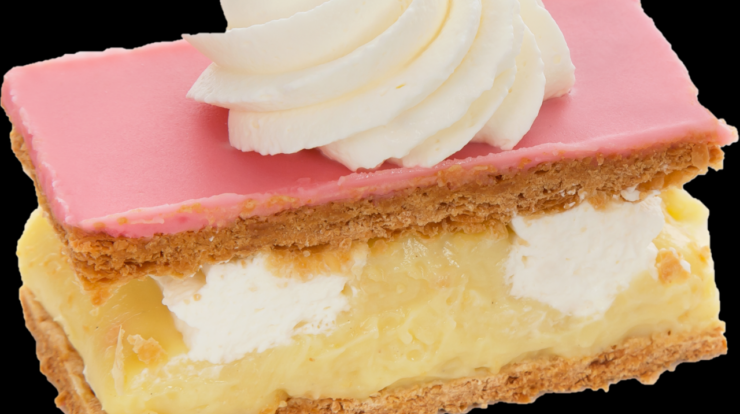
Tompouce, a delectable pastry originating from the Netherlands and Belgium, is a testament to the rich culinary heritage of these countries. With its vibrant colors, delicate layers, and sweet flavors, tompouce has become an iconic treat, enjoyed by people of all ages.
This pastry’s history, preparation, cultural significance, variations, presentation, and nutritional aspects are explored in this comprehensive guide, providing a deeper understanding and appreciation for this beloved dessert.
Tompouce: A Dutch and Belgian Pastry Delight
Tompouce, a beloved pastry in the Netherlands and Belgium, is a testament to the rich culinary heritage of these countries. Its unique combination of flavors and textures has made it a popular treat enjoyed by people of all ages.
History and Origin
The origins of tompouce can be traced back to the 18th century. It is believed to have been created by a Dutch pastry chef named Tom Pouce, who was inspired by the French mille-feuille. The name “tompouce” is a playful reference to the chef’s small stature, meaning “little Tom” in French.
Over time, tompouce evolved into a distinct pastry, with regional variations emerging in different parts of the Netherlands and Belgium. Today, it is a staple in pastry shops and bakeries throughout both countries.
Ingredients and Preparation, Tompouce
Tompouce is made from a flaky puff pastry dough that is filled with a rich vanilla custard and topped with a layer of pink fondant icing. The custard is typically made with milk, sugar, eggs, flour, and vanilla extract, while the fondant icing is made from sugar, water, and food coloring.
To prepare tompouce, the puff pastry dough is rolled out and cut into rectangles. The rectangles are then filled with the custard and baked until golden brown. Once cooled, the pastries are topped with the fondant icing.
Cultural Significance
Tompouce holds a special place in Dutch and Belgian culture. It is often served at special occasions, such as birthdays, weddings, and holidays. In the Netherlands, tompouce is also known as “oranjetompouce” because of its orange icing, which is reminiscent of the national color.
Tompouce has also been featured in popular culture. In the Dutch children’s television show “Sesamstraat,” the character Tommie uses tompouce as a treat to reward his friends.
Variations and Regional Differences
There are several variations of tompouce found in the Netherlands and Belgium. In the Netherlands, the most common variation is the “roomsoezen,” which is filled with a chocolate mousse instead of vanilla custard. In Belgium, a popular variation is the “mille-feuille,” which is made with a puff pastry dough that is filled with a layer of whipped cream and topped with a chocolate ganache.
The table below compares the ingredients, preparation methods, and flavors of different tompouces:
| Type | Ingredients | Preparation | Flavor |
|---|---|---|---|
| Tompouce | Puff pastry dough, vanilla custard, fondant icing | Baked | Sweet, creamy, flaky |
| Roomsoezen | Puff pastry dough, chocolate mousse, fondant icing | Baked | Sweet, chocolatey, flaky |
| Mille-feuille | Puff pastry dough, whipped cream, chocolate ganache | Baked | Sweet, creamy, chocolatey |
Presentation and Serving
Tompouce is typically served cold, cut into squares or rectangles. It can be garnished with whipped cream, chocolate shavings, or fresh fruit. Tompouce can also be served with a dollop of whipped cream or a scoop of ice cream on the side.
Nutritional Information and Health Considerations
Tompouce is a high-calorie pastry, so it should be consumed in moderation. A single serving of tompouce contains approximately 300 calories, 15 grams of fat, 30 grams of carbohydrates, and 10 grams of protein.
Tompouce is not a good source of vitamins or minerals. However, it does contain some calcium and iron.
For those who are concerned about their health, there are some healthier ways to enjoy tompouce. One option is to make it with whole-wheat puff pastry dough and low-fat custard. Another option is to top it with fresh fruit instead of fondant icing.
Closure: Tompouce

Tompouce, with its delectable flavors, rich cultural history, and endless variations, remains a cherished part of Dutch and Belgian culinary traditions. Whether enjoyed as a sweet treat or a centerpiece at special occasions, this pastry continues to captivate taste buds and bring joy to those who indulge in its sugary embrace.
Questions Often Asked
What is the origin of tompouce?
Tompouce originated in the Netherlands in the early 1900s, inspired by the French mille-feuille pastry.
What are the main ingredients of tompouce?
Tompouce consists of layers of puff pastry, filled with a creamy vanilla custard and topped with a pink fondant glaze.
What are the different variations of tompouce?
Variations include different fillings such as chocolate, fruit, or whipped cream, as well as variations in the glaze color and decorations.





